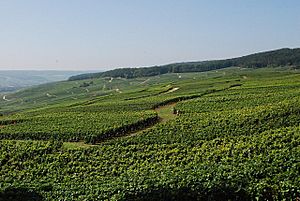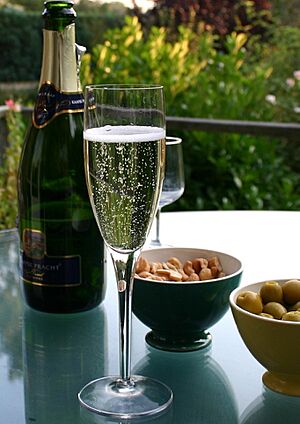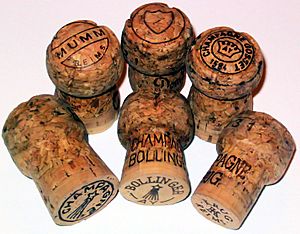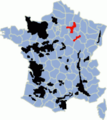Champagne (wine) facts for kids

Champagne is a special kind of sparkling wine from France. It gets its name from the Champagne region in France, where it is made. This area has many vineyards, which are farms where grapes are grown to make wine.
What makes Champagne unique is how it gets its bubbles. The bubbles come from carbon dioxide that forms naturally during a second fermentation process inside the bottle. This means the bubbles are not just added in later!
Many people call any sparkling wine "champagne," but legally, only sparkling wine made in the Champagne region of France can truly be called Champagne.
What kinds of Champagne are there?
Champagne must be made from specific types of grapes. These include white Chardonnay grapes, or red Pinot Noir and Pinot Meunier grapes. Even when red grapes are used, most Champagnes look white or sometimes pink, which is called rosé.
Champagnes are also named based on how much sugar is added to them. This affects how sweet they taste. Here's a list from the least sweet (called "dry") to the most sweet (called "wet" or "doux"):
- brut zéro or brut natural: No sugar is added at all.
- extra brut
- brut: This is the most common type of Champagne.
- extra-dry
- sec
- demi-sec
- doux: This is the sweetest type of Champagne.
Fun facts about Champagne
Champagne is famous for its bubbles! Because it's so bubbly, people sometimes call it "bubbly." For example, you might hear someone say, "We're going to have bubbly at our wedding!"
When you open a Champagne bottle, the cork can sometimes "pop" out with a loud sound, and the Champagne might spray everywhere. This is often done at celebrations, especially if the bottle is shaken first. However, usually, people try to open Champagne bottles carefully so they don't make a mess. When opened correctly, the cork should come out quietly, almost like a soft sigh.
Champagne is usually served in a special tall, narrow glass called a champagne flute. The shape of this glass helps keep the bubbles in the drink for a longer time.
It's always served cold, or "chilled." The best temperature for Champagne is between 7 to 9 °C (43 to 48 °F). Often, the bottle is kept in a bucket of ice to stay cold before and after it's opened.
Images for kids
-
Different sizes of Champagne bottles. From left to right on the ladder: Magnum (1.5 litres), full (0.75 litre), half (0.375 litre), quarter (0.1875 litre). On the floor: Balthazar (12 litres), Salmanazar (9 litres), Methuselah (6 litres), Jeroboam (3 litres).
-
Champagne on the podium of the 2007 Tour of Gippsland.
See also
 In Spanish: Champán para niños
In Spanish: Champán para niños















